First drive: Nissan Juke-R, 370Z and GT-R 2012
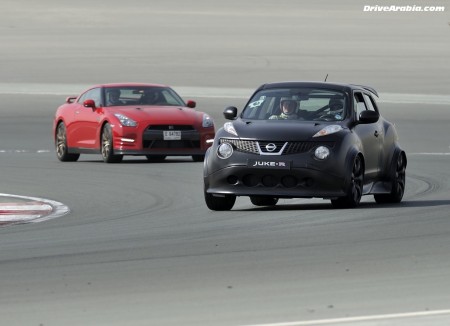
When we first read about the Nissan Juke-R, we dismissed it as a publicity stunt. Built by race engineering shop RML in the United Kingdom with the blessing of Nissan Europe as a one-off project, we figured they’d never put to use the two cars they built. But then we hear they did some track-testing in Europe. And then we hear that they were bringing the cars to Dubai to use as a pace car for the Dunlop 24-hour race in Dubai. And then we hear they’re filming a viral video as well as flying in international journalists to drive it here. And they we actually got the call to drive it ourselves, at the Dubai Autodrome. The real surprise, of course, was that they had a new Nissan GT-R as well as a Nissan 370Z on hand to compare them all.

The story behind the Nissan Juke-R is already well-known by enthusiasts now. It may be called The Joker, but it looks every bit The Batman. Aside from the obvious body mods, spoilers and 20-inch wheels, under the bonnet is the 485 hp 3.8-litre twin-turbo V6 engine taken directly from the 2010 Nissan GT-R, complete with its 6-speed automanual transaxle, with the front and rear ends joined by a modified GT-R all-wheel-drive driveline and prop-shaft. Even the cross-drilled brakes are taken from the GT-R, as are the instrument gauges, 7-inch customisable LCD display and shifter console, cut-and-pasted into the Juke’s interior. Low-mounted racing seats with five-point harnesses sit inside a visible roll-cage, while there is just a flat area where the rear seats used to be. With the dashboard moved back to accommodate the VR38DETT engine, and the AWD drivetrain taking up space behind, there isn’t any space to fit more than two seats.
The build quality is a bit dodgy, especially in the cabin, but then again, if they’re taking these things on the track for multiple rounds, we assume they’re mechanically solid. We got to drive it first in the trio, and we can honestly say it felt the most like a race-car, obviously. As I did a warm-up lap with an instructor by my side, all I could hear was wind noise, as the windows were kept a bit open since the a/c apparently decided to go kaput earlier. Warm-up done, I floored the throttle on the straight, and the thing practically flew, hitting speeds I’d never reached before at the Autodrome.

By the time I reached the end of the straight, I was doing something above 200 kph. With a turn coming up, I pounced on the brake pedal, and the Juke got a bit squirmy, but still well under control. I kept on the brake even as I entered the turn, so the tail swung out a bit before regaining grip and continuing around the corner as it was meant to. The car’s handling is characterful, to say the least, but still completely safe as I continued around the track, driving a fair bit under its limits. I was hearing the occasional squeaks from the tyres on mild understeer, but I never dared push it harder, constantly remembering that this car is two-of-a-kind.
The instructor kept egging me on, however. And by the last lap, I could hustle along at a decent pace. I drove in regular automatic mode all the way, forgoing the paddles, as I didn’t want to bother with trying to figure out the ideal shift-points on a car that I wasn’t familiar with. So I was ending up in the wrong gear a few times on some turns, too high in most cases, and thus losing speed when flooring it and forcing a downshift on exiting the turns and straightening out the steering wheel. But it steers quickly, brakes hard, and hardly rolls. In fact, there is no body roll. It may be a tad slower than a new GT-R, considering it is around 70 kilos heavier and 65 horses lighter, but it clearly has all the ingredients to take on all sorts of lesser supercars.
The GT-R, on the other hand, feels every bit as polished as I expected. I hopped into it right after the Juke-R run, a car I was familiar with, considering I’d already reviewed it on the street. It’s the latest 2012 model, complete with the 550 hp motor and all the mechanical tweaks expected from the GT-R’s never-satisfied engineers. With a better engine, suspension and brakes, the GT-R did not disappoint us from the get-go. After the warm-up lap, I hit the straight at full blast, easily hitting nearly 250 kph before having to pounce on the brake pedal for the first corner.

The corners could be entered harder and faster in the GT-R than in the Juke-R, expectedly, while the tyres could be pushed much further before they let out a squeak. The braking bits took a shorter distance and featured none of the squirminess of the Juke-R. I had the same minor issue of there not being a dedicated automatic “sport” mode, and I chose not to drive in manual mode, so once in a while I was in too high a gear going into the corners and requiring a forced full-throttle downshift when exiting a turn. I was not chasing any lap records, but if you were, you’d be better off familiarising yourself with the paddle-shifters controlling the ultra-quick 6-speed dual-clutch gearbox.
As for a casual run on the track, the GT-R is so clinically fast that you could be sitting in the wrong gears all day and still outrun everything else on the track. There’s no body roll, no swinging tail, no untoward understeer and no tension. The 370Z that was on the track with us at the same time was starting to become a rolling roadblock, even on the corners.
I hopped into that very same 370Z after my laps were done with the GT-R. The 370Z plays on a different field, it goes without saying. Still, we didn’t expect the difference to be so easily evident. On the straight, I can’t be sure, but we estimate it topped out at around 150 kph. The Z is a fine 332 hp sports car in its own right, easily taking on others in its class, but here it was being made to play alongside Godzilla, of all cars. Braking at the end of the straight, it took a bit longer to slow down, albeit still confidently without any real drama. And then turning into the first corner, its tyres started squealing earlier than its supercar siblings as we sped up around the turn.
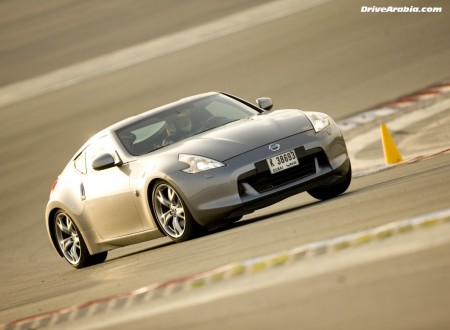
Body roll wasn’t noticeable, and grip levels were still commendable. The steering is sharp and the pedals offer decent feedback. The only thing is I again noticed the lack of a proper “sport” mode in the automatic. The 370Z liked to sit in the high gears a lot, and the need to downshift became more glaringly-obvious in this car than in the GT-R. Again, it is best to drive this car manually using the paddle-shifters once you get used to it, but we later found out that it has some semblance of aggressive automatic gear-shifts if just left in “manual” mode and revved to redline, though we weren’t going to experiment with that while already taking fast turns on a high-speed racetrack. But as the entry-level sports car of the range, the 370Z does the job perfectly.
At the end of it all, I came out with a big smile on my face, having figured out the difference between a great sports car and an all-conquering supercar when it comes to track-driving. Sometimes we tend to forget that Nissan is capable of a whole lot more than just Sunnys and Tiidas. We still haven’t figured out what the Juke-R is, but we are glad it exists in drive-ready form, even if just a prototype. We already liked the regular Juke Turbo before, but maybe the Joker with the GT-R heart will serve as a template for something else in the near future that you can actually buy in Nissan showrooms.
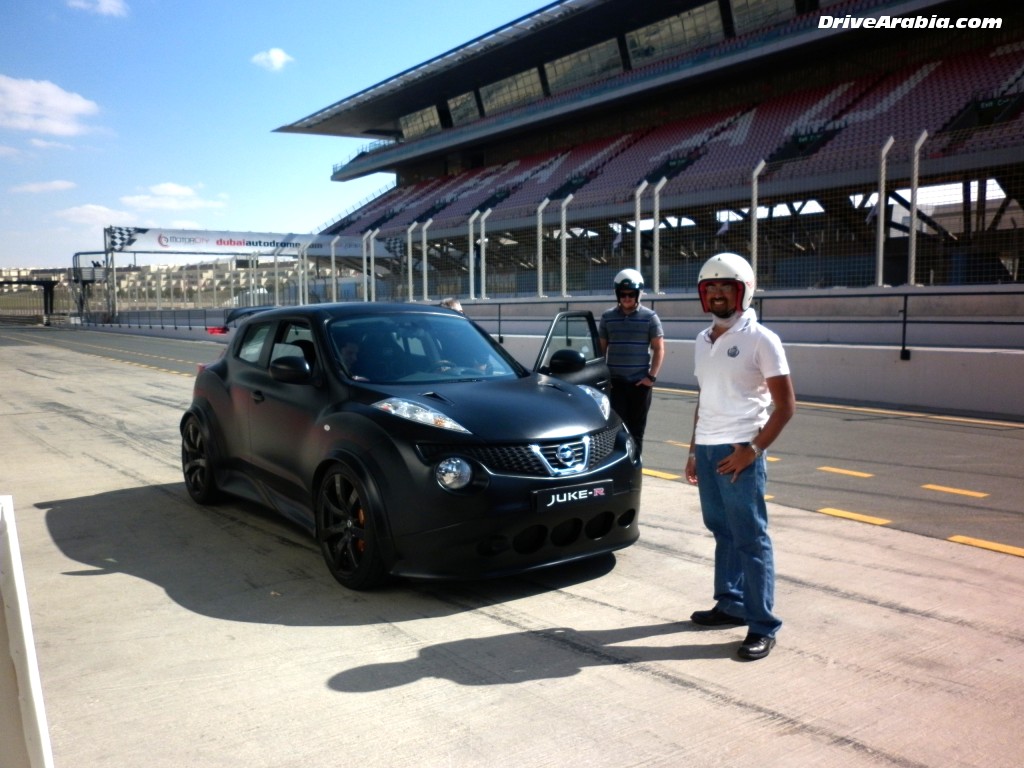
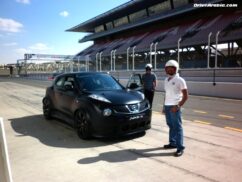
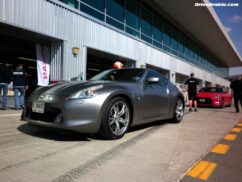
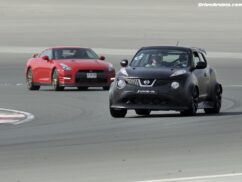
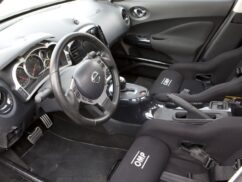
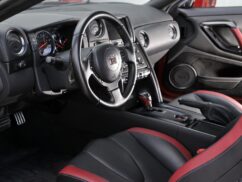
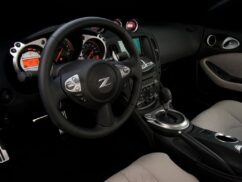
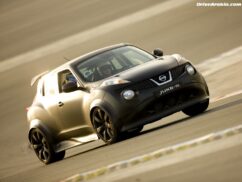
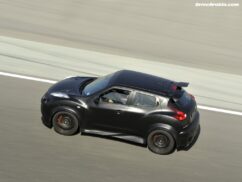
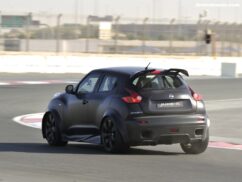
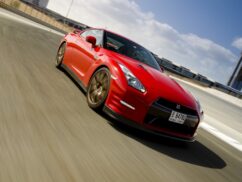
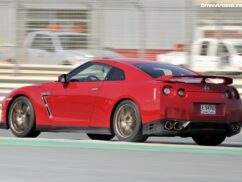
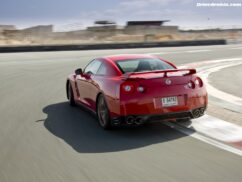
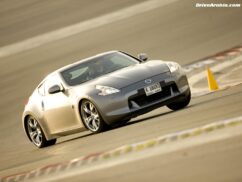
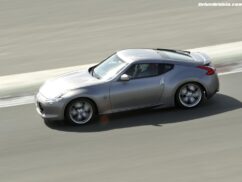
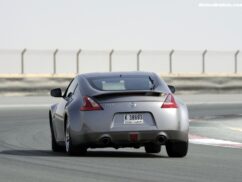
Comments
ROJ
I believe carmakers will start figuring out ways of providing lots more for less money.. Cars have become necessarily loaded with luxuries that raise the price way too much.
Toyota took a path with the new 86 which is a car priced at $25000.. with a 53:47 weight ration and driving dynamics equivalent to a Porsche Boxster. I wont be surprised if other car-makers will chose to start a battle of who sells the ‘most affordable’ performance car with the most performance figures..
Toyota, Nissan & Honda.. Have built race cars that were ahead of their time as many carmakers did in the 80s & 90s.. Its a shame to abandon such technological superiority..
Plus, Nissan can work side by side with Renault.. on building a budget performance car… Renualt has the Clio Sport and this is a serious foundation to take into consideration..
Xalan Mustafa
i thought the juke was lighter n faster, nice review though
Aditya
Yawwnn !! So the GTR is fast on the track, has less body roll etc. etc !, but we all know that ! No offense, but are these car reviews ? looks more like you’re talking to DEAR DIARY !! ;P
Dhoom
A lot of us thought the Juke-R was faster. This proves otherwise. Talk when you can afford a GT-R. Thanks for the review.
Aditya
You didnt get the point, im not talking about the car, or which is faster, I was referring to the way the piece was writen, anyways, no offense meant and none taken ! Cheers ! and besides, I CAN afford it !! 😛
Tony
KaputT not kaput 🙂
nihal
better to buy saleen s7 than juke lolz…………